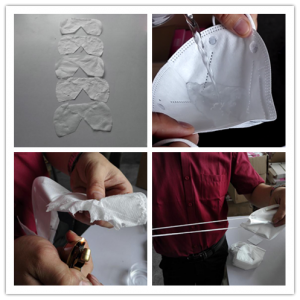First of all, we need to understand the important components of the product routine inspection process, such as the appearance of the product, the conformity of the quantity, Product compliance check, the packing method, the inspection of the box mark and the field test. Corresponding inspection steps should be matched according to different products. “Mask” is composed of fabric and process with textile properties, so it follows the particularity of textile products to verify the standardization of “mask”.

1) Product appearance inspection: check whether the outer and inner layers of the “mask” are stained, dirty or damaged by naked eye and touch. Check the earring part of the mask and see if the joint is firm. Whether the nose clip of the mask is completely wrapped by non-woven cloth, check the tightness of the nose clip. In addition, the mask should be fully extended to check whether the edges of the mask are properly pressed, and the shape of the folds should be checked after the mask is extended. Check that masks, earrings and nose clips are the correct size.
2) Product quantity conformity check: Check whether the actual completed product quantity is consistent with the PO quantity in the order.
3) Product compliance checks: A. product model is consistent with the customer ordered, whether products are for civilian or medical. If for medical, packaging requirements whether reach the standard of surgical masks, tensile test whether can meet the requirements of relevant mask of standard; General civil masks 10 n/s test is to be fulfilled within 10 Newton (for 10 seconds) according to the standard (GB/T32610-2016), surgical masks to meet 50 n/s test namely (within 50 Newton for 10 seconds). B. Stratify the mask and check whether the mask is composed of three layers: inner, middle and outer. The fabric composition should include non-woven cloth and molten spray material. C. Whether the material of the product is consistent with the customer’s requirements. For the comparison test of the material, color and gram weight respectively with the customer’s requirements or reference samples, polypropylene is the typical material for the manufacture of surgical masks.
4) Functional inspection: A. Place the mask on a piece of white paper and conduct a waterproof test. If the white paper is wet, the waterproof function of the mask does not meet the standard. B. Use an open flame to ignite the edge of the mask to test its flame retardation. A mask meeting the standard will not burn, and vice versa. C. Odor test and skin allergy test to check for pungent odor and ensure skin comfort. D. Electrostatic adsorption test: the masks with meltblown fabric inside will attract small pieces of paper.
5) Weighing check: Check the weight of the mask cut and divided into layers. As the mask is a special textile material, it must be weighed with a professional gram-plate. A sampler is used to cut the facemask of the facemask divided into layers.